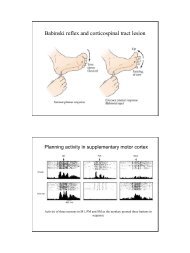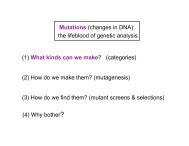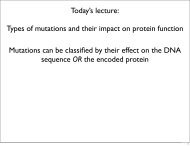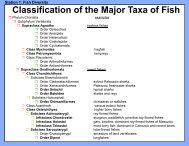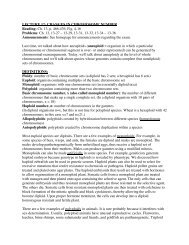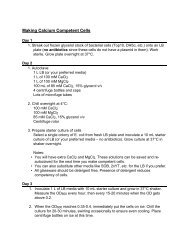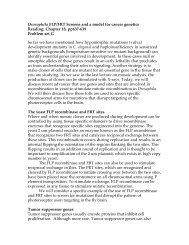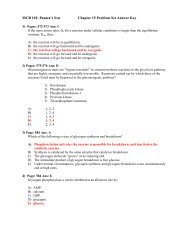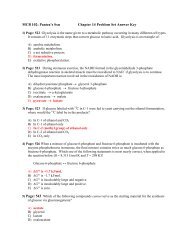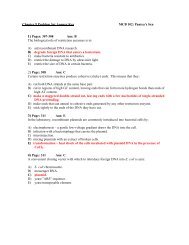You also want an ePaper? Increase the reach of your titles
YUMPU automatically turns print PDFs into web optimized ePapers that Google loves.
<strong>MCB</strong> <strong>102</strong>: Pantea’s <strong>Sxn</strong> Chapter 17 Problem Set Answer Key<br />
1) Page: 636 Ans: B<br />
Which of these is able to cross the inner mitochondrial membrane?<br />
A) Acetyl–CoA<br />
B) Fatty acyl–carnitine<br />
C) Fatty acyl–CoA<br />
D) Malonyl–CoA<br />
E) None of the above can cross.<br />
2) Pages: 637-638 Ans: C<br />
What is the correct order of function of the following enzymes of β oxidation?<br />
1. β-Hydroxyacyl-CoA dehydrogenase<br />
2. Thiolase<br />
3. Enoyl-CoA hydratase<br />
4. Acyl-CoA dehydrogenase<br />
A) 1, 2, 3, 4<br />
B) 3, 1, 4, 2<br />
C) 4, 3, 1, 2<br />
D) 1, 4, 3, 2<br />
E) 4, 2, 3, 1<br />
3) Page: 639 Ans: D<br />
If the 16-carbon saturated fatty acid palmitate is oxidized completely to carbon dioxide and water (via<br />
the β-oxidation pathway and the citric acid cycle), and all of the energy-conserving products are used<br />
to drive ATP synthesis in the mitochondrion, the net yield of ATP per molecule of palmitate is:<br />
A) 3.<br />
B) 10.<br />
C) 25.<br />
D) 108.<br />
E) 1,000.<br />
4) Pages: 634-639 Ans: B<br />
Which of the following is (are) true of the oxidation of 1 mol of palmitate (a 16-carbon saturated fatty<br />
acid; 16:0) by the β-oxidation pathway, beginning with the free fatty acid in the cytoplasm?<br />
1. Activation of the free fatty acid requires the equivalent of two ATPs.<br />
2. Inorganic pyrophosphate (PPi) is produced.<br />
3. Carnitine functions as an electron acceptor.<br />
4. 8 mol of FADH are formed.<br />
2<br />
5. 8 mol of acetyl-CoA are formed.<br />
6. There is no direct involvement of NAD +<br />
.<br />
A) 1 and 5 only<br />
B) 1, 2, and 5<br />
C) 1, 2, and 6<br />
D) 1, 3, and 5<br />
E) 5 only
5) Pages: 635-639 Ans: A<br />
The balanced equation for the degradation of CH3(CH2)10COOH via the β-oxidation pathway is:<br />
A) CH3(CH2)10COOH + 5FAD + 5NAD + + 6CoA—SH + 5H2O + ATP →<br />
6 Acetyl-CoA + 5FADH2 + 5NADH + 5H + + AMP + PPi<br />
B) CH3(CH2)10COOH + 5FAD + 5NAD + + 6CoA—SH + 5H2O →<br />
6 Acetyl-CoA + 5FADH2 + 5NADH + 5H +<br />
C) CH3(CH2)10COOH + 6FAD + 6NAD + + 6CoA—SH + 6H2O + ATP →<br />
6 Acetyl-CoA + 6FADH2 + 6NADH + 6H + + AMP + PPi<br />
D) CH3(CH2)10COOH + 6FAD + 6NAD + + 6CoA—SH + 6H2O →<br />
6 Acetyl-CoA + 6FADH2 + 6NADH + 6H +<br />
6) Page: 638 Ans: A<br />
The conversion of palmitoyl-CoA (16:0) to myristoyl-CoA (14:0) and 1 mol of acetyl-CoA by the βoxidation<br />
pathway results in the net formation of:<br />
A) 1 FADH 2 and 1 NADH.<br />
B) 1 FADH 2 and 1 NADPH.<br />
C) 1 FADH 2 , 1 NADH, and 1 ATP.<br />
D) 2 FADH 2 and 2 NADH.<br />
E) 2 FADH 2 , 2 NADH, and 1 ATP.<br />
7) Page: 642 Ans: E<br />
The following fatty acid, in which the indicated carbon is labeled with 14<br />
C, is fed to an animal:<br />
14<br />
CH (CH ) COOH<br />
3 2 9<br />
After allowing 30 minutes for fatty acid β oxidation, the label would most likely be recovered in:<br />
A) acetyl-CoA.<br />
B) beta-hydroxy butyryl-CoA.<br />
C) both acetyl-CoA and propionyl-CoA.<br />
D) palmitoyl-CoA.<br />
E) propionyl-CoA.<br />
8) Page: 642 Ans: D<br />
The carbon atoms from a fatty acid with an odd number of carbons will enter the citric acid cycle as<br />
acetyl-CoA and:<br />
A) butyrate.<br />
B) citrate.<br />
C) malate.<br />
D) succinyl-CoA.<br />
E) α-ketoglutarate.<br />
9) Page: 650 Ans: C<br />
Ketone bodies are formed in the liver and transported to the extrahepatic tissues mainly as:<br />
A) acetoacetyl-CoA.<br />
B) acetone.<br />
C) beta-hydroxybutyric acid.<br />
D) beta-hydroxybutyryl-CoA.<br />
E) lactic acid.
10) Page: 631<br />
Why is it more efficient to store energy as lipid rather than as glycogen?<br />
Ans: First, the energy yield per gram of lipid (about 38 kJ/g) is more than twice that for<br />
carbohydrate (about 17 kJ/g). Second, lipid is stored as anhydrous lipid droplets, but<br />
carbohydrates such as glycogen and starch are stored hydrated, and the water of hydration<br />
roughly triples the effective weight of the carbohydrate, reducing the energy yield to about 6<br />
kJ/g.<br />
11) Page: 638<br />
Draw the four basic steps in the oxidation of a saturated fatty acid (the β-oxidation pathway). Show<br />
structures, name enzymes, and indicate where any cofactors participate.<br />
Ans: See Fig. 17-8a, p. 638.<br />
12) Page: 638<br />
The β oxidation of fatty acids begins with this activation reaction:<br />
R–CH2–CH2–CH2–COOH + ATP + CoA–SH→<br />
R–CH2–CH2–CH2–CO–S–CoA + AMP + PPi<br />
What are the next two steps (after transport into the mitochondria)? Show structures and indicate<br />
where any cofactors participate.<br />
Ans: The reactions are those catalyzed by fatty acyl–CoA dehydrogenase and enoyl hydratase.<br />
See Fig. 17-8a, p. 638.<br />
13) Pages: 651-652<br />
What are ketone bodies and why do they form during fasting?<br />
Ans: The ketone bodies, acetoacetate, β-hydroxybutyrate, and acetone, are overproduced<br />
during fasting, when fatty acids from stored triacylglycerols become the principle oxidizable<br />
fuel. Accumulation of acetyl-CoA and its precursor acetoacetyl-CoA favors ketone body<br />
formation. Because oxaloacetate is used for gluconeogenesis, it is withdrawn from the citric<br />
acid cycle, bringing that cycle to a near halt. The acetyl-CoA that is produced by β oxidation<br />
can no longer be oxidized via the citric acid cycle so it accumulates.



